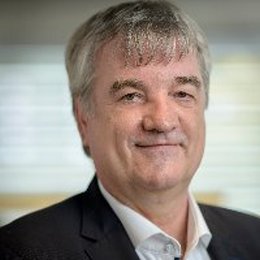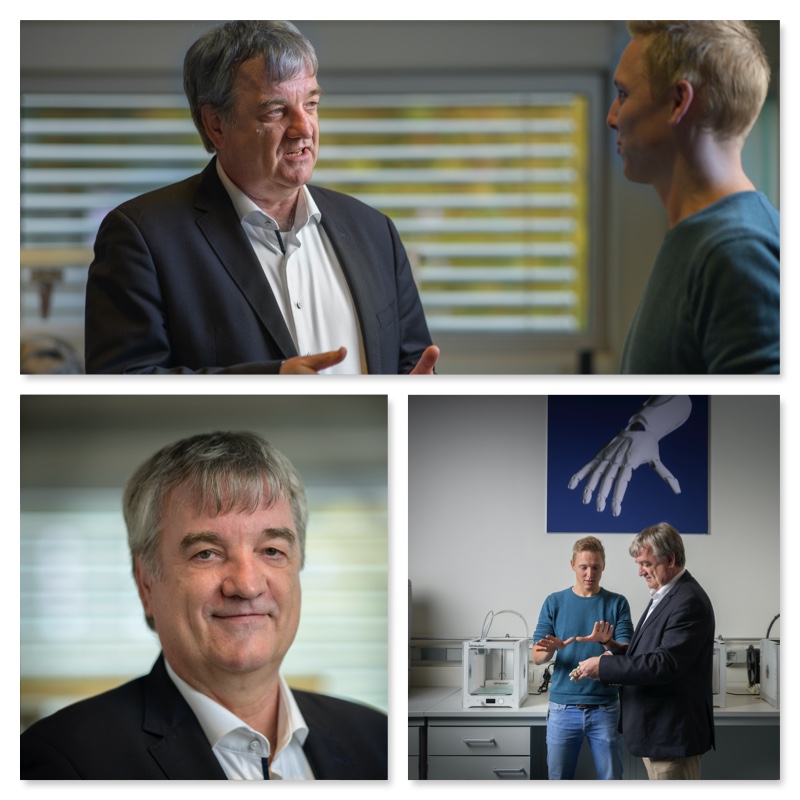Bart Koopman creates best environment for biomechanical engineering
“I want to achieve tangible results, in every sense of the word. That is why I am a Biomechanical Engineer and what makes it worthwhile and rewarding,” states Bart Koopman, chair of the Biomechanical Engineering Department at the University of Twente (UT) and member of the board of TechMed. Koopman is a UT-veteran, where he graduated and received his PhD in 1989. He has never left since. In 1998, the scientist was one of the five people in the research group Biomechanical Engineering. This group still exists and has grown to more than 70 researchers who mainly focus on developing applications in the medical fields of rehabilitation, orthopaedics and neurology.
“My research always combined biomechanical designs and applications that support movements of the human body with fundamental mechanics. Exo-skeletons are prime examples of this work. Nowadays, we use MRI- and CT-scans to produce personalized designs for actual use by patients. But it started by creating models of human movement to predict the consequences of various conditions. We still use these models to a certain extent, specifically when we still need a reliable prediction for the effects of surgery on a patient,” Koopman explains. “If, for example, a patient has a tumor in his leg, it is often located near the growth plates. In most cases, that is where tissue is surgically removed. We use our models to predict whether this is necessary or if an amputation would be a better option. To make these predictions as accurate as possible, we use data from the MRI- and CT-scans, as well as simulations of all the possible scenarios.”
Koopmans role has changed over the years. He explains: “In my current role as chair of the department, I’m less involved in the actual studies we are conducting. My main responsibility is to create the best possible environment and conditions for excellent research. I was a good programmer in my time, but the scientists and even current students in my department are way better. I have a more tactical role in which I combine and share my knowledge and experience.”
Research and Education
Teaching students has been a part of Koopmans past work as well. “I have designed and taught a number of classes, but it is less part of my current role. For a starting scientist, teaching classes is very important. I see the development of students as an essential part of our scientific work at the university. As a teacher, you have to enthuse them for your profession. Our department attracts lots of interest from students, they see the developments in biomechanical engineering in our labs. It helps that we have a lot of prototypes and other devices, so students can literally see and touch the results of our work. We expect this interest to grow exponentially in the coming years, our line of work is still in its early stages. The development of new products and applications will speed up and this will require more resources and scientists to facilitate the growth. I firmly believe the best is yet to come for our department and I look forward to be a part of the further growth of our department and the university as a whole. The main strength of UT has always been the multidisciplinary work of our faculties. The new TechMed Centre is a prime example of the way we work together and will provide us with new possibilities to grow and develop our research.”
About Bart Koopman
Professor Bart Koopman graduated with a degree in mechanical engineering, specialising in fluid dynamics, and then received his PhD at the end of 1989 from the University of Twente, the Netherlands, on the biomechanics of movement. When the Laboratory of Biomechanical Engineering was founded in 1990, he started working there as a Faculty Member on topics related to the co-ordination of movement. Although his research and publications have involved areas as diverse as biomechatronics, robotics and implant mechanics, these have predominantly focussed on applications in the medical fields of rehabilitation, orthopaedics and neurology. Professor Koopman had supervised more than 300 higher degree research students in Biomedical Engineering. Since 2005 he has served as Chair of the Biomechanical Engineering Department which, during this time, has developed into one of the largest Faculty groups. All research is embedded in the Technological Medical (TechMed) Centre of the University of Twente and facilitated by a strong cooperation and collaboration with various technological and clinical partners.


